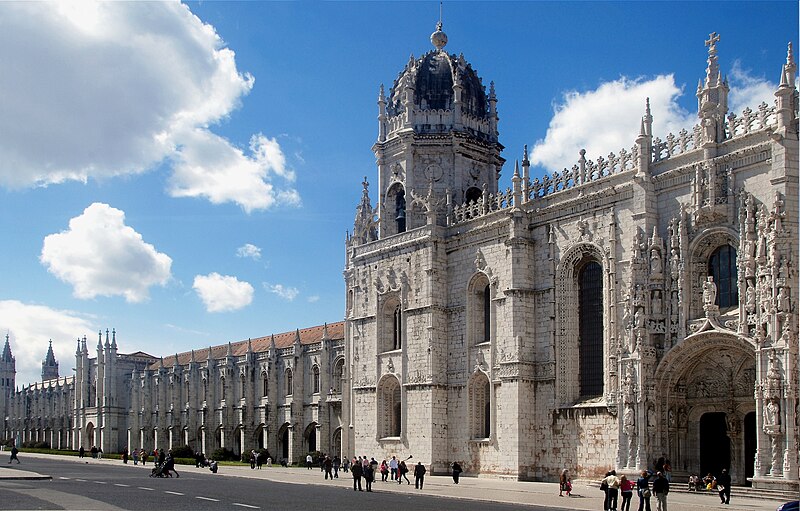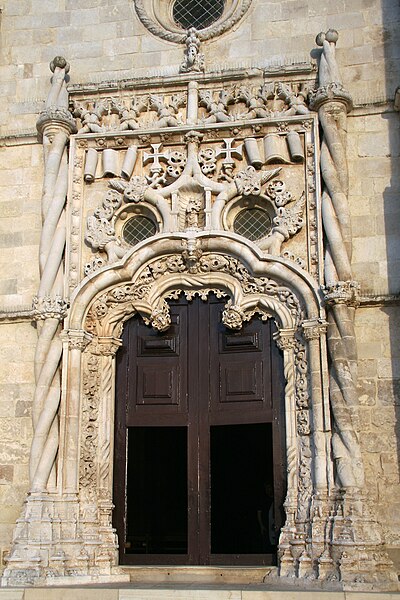Manueline


간혹 포르투갈 후기 고딕 양식이라고도 하는 마누엘린(마누엘 양식; 포르투갈어 : 에스칠루 마누엘리누)은 포르투갈 르네상스와 대항해 시대인 16세기에 시작된 호화롭고 복합적인 포르트갈 건축 양식이다. 마누엘린 건축은 바스코 다 가마(1460년대~1524)와 페드로 알바레스 카브랄(c.1467/1468~c.1520)이 항해를 통해 발견한 표현을 해양 요소와 통합한다. 이 혁신적인 양식은 플래터레스크 양식, 무데하르 양식, 이탈리안 및 플레미시(플랑드르) 건축의 독창적인 모티브 및 영향과 함께 후기 고딕 플랑부아양 건축의 양상을 합성한다. 그것은 후기 고딕에서 르네상스로의 전환을 의미한다. 마누엘린에서의 교회와 수도원 건설은 주로 아프리카 및 인도와의 수익성 높은 향신료 무역 수익으로 자금을 조달했다.
The Manueline (Portuguese: estilo manuelino, IPA: [ɨʃˈtilu mɐnweˈɫinu]), occasionally known as Portuguese late Gothic, is the sumptuous, composite Portuguese architectural style originating in the 16th century, during the Portuguese Renaissance and Age of Discoveries. Manueline architecture incorporates maritime elements and representations of the discoveries brought from the voyages of Vasco da Gama and Pedro Álvares Cabral. This innovative style synthesizes aspects of Late Gothic Flamboyant architecture with original motifs and influences of the Plateresque, Mudéjar, Italian, and Flemish architecture. It marks the transition from Late Gothic to Renaissance. The construction of churches and monasteries in Manueline was largely financed by proceeds of the lucrative spice trade with Africa and India.
이 양식은 오랜 시간 후 포르투 세구루의 자작(子爵), 프란시스코 아돌포 데 파른하겐이 1842년 그의 저서 『고딕 양식 건축을 중심으로 한 다양한 용어에 대한 설명이 포함된, 벨렘 수도원의 역사 및 설명』에서 (리스본의) 제로니무스 수도원에 대해 설명하면서 붙여진 이름이다. 파른하겐은 이 건축 양식의 발전과 동시에 재위(1495~1521)했던 마누엘 1세의 이름을 따서 명명했다. 이 양식은 포르투갈 항해사들이 아프리카 해안 지역에서 브라질과 극동으로 향하는 항로를 발견하는 놀라운 항해의 성공에 크게 영향을 받았으며, 동인도 사원의 양식과 장식에 많은 영향을 받았다.
The style was given its name, many years later, by Francisco Adolfo de Varnhagen, Viscount of Porto Seguro, in his 1842 book Noticia historica e descriptiva do Mosteiro de Belem, com um glossario de varios termos respectivos principalmente a architectura gothica, in his description of the Jerónimos Monastery. Varnhagen named the style after King Manuel I, whose reign (1495–1521) coincided with its development. The style was much influenced by the astonishing successes of the voyages of discovery of Portuguese navigators, from the coastal areas of Africa to the discovery of Brazil and the ocean routes to the Far East, drawing heavily on the style and decorations of East Indian temples.
비록 이 양식의 시대는 오래 가지 못했지만(1490~1520), 포르투갈 예술 발전에 중요한 역할을 했다. 양식의 영향은 왕보다 오래 지속되었다. 그것은 새로운 해상력을 기념하며 건축(교회, 수도원, 궁전, 성)에서 그 모습을 드러냈고, 조각, 회화, 귀금속으로 만든 예술품, 파양스 도자기 및 가구와 같은 다른 예술 분야로 확장되었다.
Although the period of this style did not last long (from 1490 to 1520), it played an important part in the development of Portuguese art. The influence of the style outlived the king. Celebrating the newly maritime power, it manifested itself in architecture (churches, monasteries, palaces, castles) and extended into other arts such as sculpture, painting, works of art made of precious metals, faience and furniture.

특성
Characteristics
이 장식적인 양식은 정문, 창문, 기둥 및 아케이드에 고도의 기교를 보여 주는 복잡한 장식이 특징이다. 말기에는 토마르에서와 같이 지나치게 활기가 넘치는 경향이 있었다.
This decorative style is characterized by virtuoso complex ornamentation in portals, windows, columns and arcades. In its end period it tended to become excessively exuberant as in Tomar.
복잡하게 조각된 이 석조 작업에는 몇 가지 요소가 규칙적으로 나타난다:
Several elements appear regularly in these intricately carved stoneworks:
- 선박에 사용되는 요소 : 혼천의(渾天儀)(항법 도구이자 마누엘 1세의 개인 상징 및 우주의 상징), 구체, 닻, 앵커 체인, 로프 및 케이블.
- 조개 껍질, 진주 그리고 해초의 끈과 같은 바다의 요소.
- 월계수 가지, 참나무 잎, 도토리, 앵속각(罌粟殼), 옥수숫대, 엉겅퀴와 같은 식물 모티브.
- 최초의 발견 항해에서 중요한 역할을 하고 자금을 지원한 군대인 그리스도 기사단(구 성전 기사단)의 십자가와 같은 기독교의 상징. 이 기사단의 십자가는 포르투갈 선박의 돛을 장식했음.
- 새로 발견된 땅의 요소 (예: 인도 건물에서 영향을 받은 이슬람 선조세공 작업을 암시하는, 바탈랴 수도원의 왕실 회랑에 있는 문양)
- 꼬인 밧줄처럼 조각된 기둥
- 문과 창문의 반원형 아치(고딕 양식의 첨두아치 대신), 때로는 3개 이상의 볼록한 곡선으로 구성됨
- 여러 개의 기둥
- 8면 주두
- 대칭성 결여
- 원추형 첨탑
- 비스듬한 총안
- 벽감 또는 캐노피가 있는 화려한 정문
- elements used on ships: the armillary sphere (a navigational instrument and the personal emblem of Manuel I and also symbol of the cosmos), spheres, anchors, anchor chains, ropes and cables.
- elements from the sea, such as shells, pearls and strings of seaweed.
- botanical motifs such as laurel branches, oak leaves, acorns, poppy capsules, corncobs, thistles.
- symbols of Christianity such as the cross of the Order of Christ (former Knights Templar), the military order that played a prominent role and helped finance the first voyages of discovery. The cross of this order decorated the sails of the Portuguese ships.
- elements from newly discovered lands (such as the tracery in the Royal Cloister of the Batalha Monastery, suggesting Islamic filigree work, influenced by buildings in India)
- columns carved like twisted strands of rope
- semicircular arches (instead of Gothic pointed arches) of doors and windows, sometimes consisting of three or more convex curves
- multiple pillars
- eight-sided capitals
- lack of symmetry
- conical pinnacles
- bevelled crenellations
- ornate portals with niches or canopies.


사례
Examples
1521년 마누엘 1세 왕이 사망했을 때, 그는 62개의 건설 프로젝트에 자금을 지원했다. 그렇지만, 포르투갈의 많은 원래의 마누엘린 건축은 1755년 리스본 지진과 뒤이은 쓰나미로 인해 대부분 손실되거나 복원할 수 없을 정도로 손상되었다. 리스본에서는, 마누엘 1세 왕의 거주지인 리베이라 궁전과 왕립 모든 성인의 병원(올세인츠 왕립 병원)이 여러 교회와 함께 파괴되었다. 그러나 이 도시에는 여전히 히에로니무스 수도원(주로 디오고 보이타카와 주앙 드 카스티요가 디자인)과 벨렘 타워의 작은 요새(프란시스코 데 아루다가 디자인)에서 이 양식의 뛰어난 사례가 남아 있다. 두 곳 모두 벨렘 지역에서 서로 가깝게 위치해 있다. 리스본 시내에 있는 노수 세뇨라 다 콘세이상 벨류(콘세이상 벨류의 성모 교회)의 정문도 파괴된 채로 남아 있다.
When King Manuel I died in 1521, he had funded 62 construction projects. However, much original Manueline architecture in Portugal was lost or damaged beyond restoration in the 1755 Lisbon earthquake and subsequent tsunami. In Lisbon, the Ribeira Palace, residence of King Manuel I, and the Hospital Real de Todos os Santos were destroyed, along with several churches. The city, however, still has outstanding examples of the style in the Jerónimos Monastery (mainly designed by Diogo Boitac and João de Castilho) and in the small fortress of the Belém Tower (designed by Francisco de Arruda). Both are located close to each other in the Belém neighbourhood. The portal of the Church of Nossa Senhora da Conceição Velha, in downtown Lisbon, has also survived destruction.
리스본 외곽에 있는 토마르의 그리스도 수녀원 교회와 사제단 회의장(챕터 하우스)은 마누엘린 양식의 주요 기념물이다. 특히, 유기적이고 꼬인 로프 형태의 환상적인 조각이 돋보이는 챕터 하우스의 큰 창은 마누엘린 양식의 가장 뛰어난 업적 중 하나다.
Outside Lisbon, the church and chapter house of the Convent of Christ at Tomar (designed by Diogo de Arruda) is a major Manueline monument. In particular, the large window of the chapter house, with its fantastic sculptured organic and twisted rope forms, is one of the most extraordinary achievements of the Manueline style.
다른 주요 마누엘린 기념물로는 왕립 회랑의 아케이드 스크린(디오고 보이타카가 디자인)과 바탈랴 수도원 및 신트라 왕궁에 있는 미완성 예배당(마테우스 페르난데스의 디자인)이 있다.
Other major Manueline monuments include the arcade screens of the Royal Cloister (designed by Diogo Boitac) and the Unfinished Chapels (designed by Mateus Fernandes) at the Monastery of Batalha and the Royal Palace of Sintra.
다른 주목할만한 마누엘린 양식 건물로는 세투발의 예수 수도원(디오고 보이타카가 디자인한 가장 초기의 마누엘린 양식 교회 중 하나), 코임브라의 산타 크루즈 수도원, 골강, 빌라두콘드, 모우라, 카민야, 올리벤사의 주요 교회, 그리고 브라가(본당), 비제우(네이브의 리브 볼트), 구아르다(주요 정문, 필라, 볼팅)의 대성당 일부가 있다. 마누엘린 양식의 관공서 건물은 에보라(페드로 데 트릴리오, 디오고 데 아루다 및 프란시스코 데 아루다가 제작한 1525년 에보라 왕궁이 있던 곳)와 1531년 에보라몬체 성, 비아나두카스텔루, 기마랑이스 및 일부 다른 도시에 있다.
Other remarkable Manueline buildings include the church of the Monastery of Jesus of Setúbal (one of the earliest Manueline churches, also designed by Diogo Boitaca), the Santa Cruz Monastery in Coimbra, the main churches in Golegã, Vila do Conde, Moura, Caminha, Olivença and portions of the cathedrals of Braga (main chapel), Viseu (rib vaulting of the nave) and Guarda (main portal, pillars, vaulting). Civil buildings in Manueline style exist in Évora (home to the Évora Royal Palace of 1525, by Pedro de Trillo, Diogo de Arruda and Francisco de Arruda) and the Castle of Évoramonte of 1531), Viana do Castelo, Guimarães and some other towns.
양식은 장식 예술로 확장되었고 포르투갈 제국 전역, 아조레스 제도, 마데이라 제도, 북아프리카 , 브라질, 포르투갈령 인도의 고아, 심지어 중국 마카오의 소수 거주지까지 퍼져나갔다. 스페인 남부, 카나리아 제도, 북아프리카, 페루와 멕시코의 옛 스페인 식민지에서도 그 영향력을 확인할 수 있다.
The style was extended to the decorative arts and spread throughout the Portuguese Empire, to the islands of the Azores, Madeira, enclaves in North Africa, Brazil, Goa in Portuguese India and even Macau, China. Its influence is apparent in southern Spain, the Canary Islands, North Africa and the former Spanish colonies of Peru and Mexico.
유명한 마누엘린 아티스트
Famous Manueline artists
건축가
Architects
- 디오고 보이타카
- 마테우스 페르난데스
- 디오고 데 아루다
- 프란시스코 데 아루다
- 주앙 데 카스틸류
- Diogo Boitac
- Mateus Fernandes
- Diogo de Arruda
- Francisco de Arruda
- João de Castilho
화가
Painters
- 바스코 페르난데스
- 호르헤 아폰소
- 크리스토방 데 피게이레두
- 가르시아 페르난데스
- 그레고리오 로페스
- Vasco Fernandes
- Jorge Afonso
- Cristóvão de Figueiredo
- Garcia Fernandes
- Gregório Lopes
갤러리
Gallery





















- 출처 : 「Manueline」, Wikipedia(en), 2020.12.19.